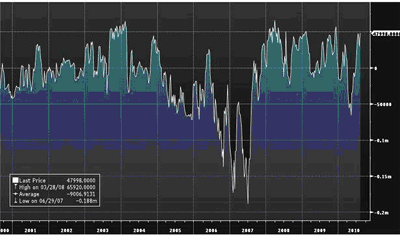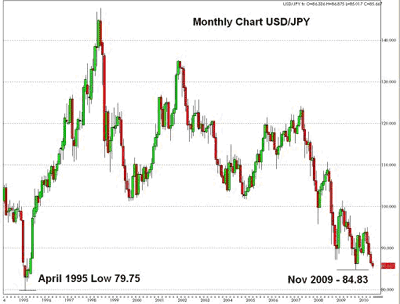The dollar has stabilized and even rebounded slightly against all of the major currencies in the past 24 hours. The possibility of further quantitative easing by the Fed should keep the greenback under pressure for the next 24 hours. Although the outcome of the Fed meeting could have a significant impact on the US dollar, it will be difficult for the Fed to do anything to halt the broad-based downtrend in the greenback. The dollar should rebound if there is no additional QE, regardless of how small it may be, but the rally will be short-lived as traders push their expectations for additional stimulus out to September.
The Case for Further USD/JPY Weakness
Therefore, we still expect USD/JPY to test and break its November 27, 2009 low of 84.83. Speculation about intervention by Japanese officials has been growing in recent weeks, but realistically, the chance of physical intervention is extremely low. The last time the Ministry of Finance intervened in the yen to stop it from rising was in March 2004, and at that time, USD/JPY was trading 17% higher than current levels. This suggests that if the Japanese were to intervene, it would have happened a long time ago. In fact, over the past six years, Japanese officials have only resorted to verbal intervention, and like the boy who cried wolf, their threats have become far less potent through the years. For example, USD/JPY is only marginally higher despite Japanese finance minister Noda's warning last night that the government is "watching forex moves carefully" and "excessive, disorderly forex moves are undesirable and would hurt the economy." Since the weakness in USD/JPY is largely attributed to deteriorating US fundamentals and evaporating US yields, intervention will only provide a temporary boost for the currency pair.
At the same time, intervention in USD/JPY extremely unlikely because it is not a smart investment decision to continue accumulating dollars when it is falling and yielding next to nothing. The recent decline in USD/JPY has taken a big bite out of Japan's $1 trillion of US dollar reserves. China also recently revalued their currency, reducing the need for Japanese intervention and trade numbers have not been horrid. Central banks know that intervention is only effective when it is coordinated, and there is little chance the US government will support currency manipulation through intervention at this time. The decision to intervene in a currency has always been as much of a political decision as an economic one.
The only fundamental way USD/JPY can stage a meaningful turnaround would be if US yields stop falling and start rising. This would only happen if US economic data suddenly surprises to the upside on a consistent basis, which is not likely to occur anytime soon. The other possibility is a short squeeze. The latest data from the CFTC shows that long JPY positions are at the highest levels this year and within a whisker of the 2009 highs.
Latest CFTC USD/JPY Data
JPY Seasonality in August
Also, USD/JPY has a very strong tendency to fall in the month of August. Since 1998, USD/JPY weakened every August except for 2006 and 2009 (see chart below). The reason why there is strong seasonality in favor of USD/JPY weakness this month is because of the reinvestment of bonus payments received on Toshin investments in July and the repatriation of Treasury coupon payments in mid August. Also, there tends to be more hedging by exporters ahead of Obon week, which is one of the most important holiday seasons in Japan.
A break below the November low of 84.83 would leave USD/JPY vulnerable for a move down to its 15-year low of 79.75.
By Kathy Lien of KathyLien.com
Kathy will be a speaker at the upcoming Futures and Forex Expo in Las Vegas on September 23-25. Register now for free!






















